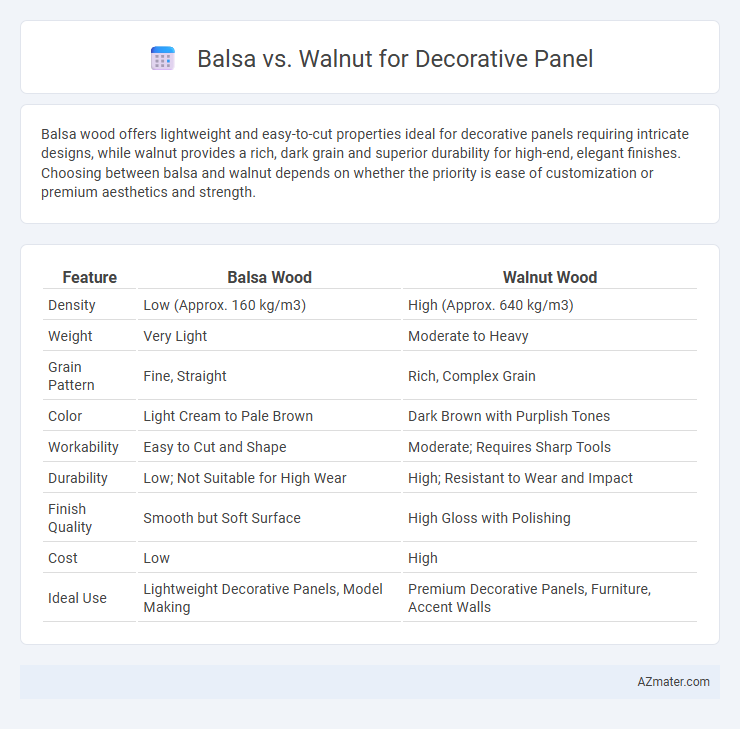Balsa wood offers lightweight and easy-to-cut properties ideal for decorative panels requiring intricate designs, while walnut provides a rich, dark grain and superior durability for high-end, elegant finishes. Choosing between balsa and walnut depends on whether the priority is ease of customization or premium aesthetics and strength.
Table of Comparison
| Feature | Balsa Wood | Walnut Wood |
|---|---|---|
| Density | Low (Approx. 160 kg/m3) | High (Approx. 640 kg/m3) |
| Weight | Very Light | Moderate to Heavy |
| Grain Pattern | Fine, Straight | Rich, Complex Grain |
| Color | Light Cream to Pale Brown | Dark Brown with Purplish Tones |
| Workability | Easy to Cut and Shape | Moderate; Requires Sharp Tools |
| Durability | Low; Not Suitable for High Wear | High; Resistant to Wear and Impact |
| Finish Quality | Smooth but Soft Surface | High Gloss with Polishing |
| Cost | Low | High |
| Ideal Use | Lightweight Decorative Panels, Model Making | Premium Decorative Panels, Furniture, Accent Walls |
Introduction to Balsa and Walnut for Decorative Panels
Balsa wood, known for its ultra-lightweight and soft texture, offers excellent workability and a smooth finish ideal for intricate decorative panel designs. Walnut wood features a rich, dark grain and robust durability, providing a luxurious and elegant appearance suitable for high-end decorative panels. Choosing between balsa and walnut depends on the desired balance of weight, strength, and aesthetic appeal in decorative panel applications.
Material Overview: Balsa Wood
Balsa wood, renowned for its lightweight and soft texture, offers exceptional ease of cutting and shaping, making it ideal for intricate decorative panels. Its cellular structure provides excellent insulating properties, while the pale, uniform color serves as a versatile base for various finishes and paints. Compared to denser woods like walnut, balsa excels in applications prioritizing minimal weight without sacrificing aesthetic adaptability.
Material Overview: Walnut Wood
Walnut wood is a dense, hardwood known for its rich, dark brown color and intricate grain patterns, making it a premium choice for decorative panels. Its durability, resistance to warping, and smooth finish enhance the aesthetic appeal and longevity of interior surfaces. Compared to lighter woods like balsa, walnut provides a more luxurious, elegant look suitable for high-end applications and sophisticated design schemes.
Aesthetic Appeal: Balsa vs Walnut
Walnut wood offers a rich, dark brown hue with intricate grain patterns that enhance the luxurious aesthetic of decorative panels, making it ideal for high-end interiors seeking warmth and depth. Balsa, on the other hand, features a light, nearly white color with minimal grain texture, providing a clean and modern look that suits minimalist or Scandinavian design themes. The contrast between walnut's robust, elegant appearance and balsa's subtle, airy tone allows designers to select panels that best align with the desired visual impact and style of a space.
Durability and Strength Comparison
Walnut offers superior durability and strength compared to balsa, making it ideal for decorative panels that require long-lasting structural integrity. Balsa is significantly lighter and softer, which compromises its resistance to dents and impact, limiting its use in high-traffic or heavy-duty applications. Walnut's dense grain and hardness provide enhanced resistance to wear, making it a more robust choice for decorative wood paneling.
Weight Differences and Handling
Balsa wood, known for its extremely low density of around 160 kg/m3, is significantly lighter than walnut, which has a density of approximately 640 kg/m3, making it easier to handle and install in decorative panels. The lightweight nature of balsa reduces transportation costs and simplifies mounting, while walnut's heavier weight offers greater durability but requires more robust support structures. This weight difference impacts both the ease of manipulation during fabrication and the structural requirements for the final decorative panel installation.
Workability: Cutting and Shaping
Balsa wood offers exceptional workability for decorative panels due to its lightweight and soft texture, making cutting and shaping effortless with hand tools or machinery. In contrast, walnut is denser and harder, requiring sharper tools and more effort to achieve precise cuts and intricate shapes but providing superior durability and a premium finish. Choosing between balsa and walnut depends on balancing ease of fabrication against desired strength and aesthetic quality.
Cost Implications for Decorative Panels
Balsa wood is significantly more cost-effective compared to walnut, making it a popular choice for budget-conscious decorative panels without compromising on lightweight properties. Walnut offers a premium aesthetic and exceptional durability but comes with a higher price tag, which can substantially increase project costs. Choosing between balsa and walnut for decorative panels depends largely on balancing cost limitations with desired visual appeal and longevity.
Environmental Impact and Sustainability
Balsa wood, known for its rapid growth and renewable qualities, offers a lower environmental impact compared to slower-growing walnut, which requires more resources and time to mature. Walnut panels, while prized for their durability and rich aesthetic, often involve more intensive forestry practices that can affect biodiversity and carbon sequestration. Choosing balsa for decorative panels supports sustainable forestry efforts due to its fast replenishment rate and lesser ecological footprint.
Best Uses: Choosing Between Balsa and Walnut
Balsa wood, known for its lightweight and easy-to-cut properties, is ideal for decorative panels in applications requiring minimal structural support, such as model making or lightweight wall features. Walnut offers superior durability, rich grain patterns, and a luxurious appearance, making it the preferred choice for high-end interior panels and furniture where aesthetic appeal and strength are paramount. Selecting between balsa and walnut depends on balancing the need for lightness with desired visual impact and long-term durability.

Infographic: Balsa vs Walnut for Decorative Panel
 azmater.com
azmater.com